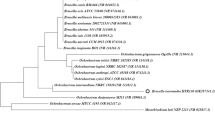Abstract
When incubated with a creosote-polycyclic aromatic hydrocarbons (PAHs) mixture, the pyrene-degrading strain Mycobacterium sp. AP1 acted on three- and four-ring components, causing the simultaneous depletion of 25% of the total PAHs in 30 days. The kinetics of disappearance of individual PAHs was consistent with differences in aqueous solubility. During the incubation, a number of acid metabolites indicative of distinctive reactions carried out by high-molecular-weight PAH-degrading mycobacteria accumulated in the medium. Most of these metabolites were dicarboxylic aromatic acids formed as a result of the utilization of growth substrates (phenanthrene, pyrene, or fluoranthene) by multibranched pathways including meta- and ortho-ring-cleavage reactions: phthalic acid, naphthalene-1,8-dicarboxylic acid, phenanthrene-4,5-dicarboxylic acid, diphenic acid, Z-9-carboxymethylenefluorene-1-carboxylic acid, and 6,6′-dihydroxy-2,2′-biphenyl dicarboxylic acid. Others were dead-end products resulting from cometabolic oxidations on nongrowth substrates (fluorene meta-cleavage product). These results contribute to the general knowledge of the biochemical processes that determine the fate of the individual components of PAH mixtures in polluted soils. The identification of the partially oxidized compounds will facilitate to develop analytical methods to determine their potential formation and accumulation in contaminated sites.



Similar content being viewed by others
Change history
01 March 2008
The original version of this article unfortunately contained a mistake. The presentation of Table 2 contains an error. The correct version is given below.
References
Arias L, Bauzá J, Tobella J, Vila J, Grifoll M (2007) A microcosm system and an analytical protocol to assess PAH degradation and metabolite formation in soils. Biodegradation (in press), doi: https://doi.org/10.1007/s10532-007-9148-0
Bouchez M, Blanchet D, Bardin V, Haeseler F, Vandecasteele J-P (2000) Efficiency of defined strains and of soil consortia in the biodegradation of polycyclic aromatic hydrocarbon (PAH) mixtures. Biodegradation 10:429–435
Cerniglia CE (2000) Recent advances in the biodegradation of polycyclic aromatic hydrocarbons by Mycobacterium species. The utilization of bioremediation to reduce soil contamination: problems and solutions. In: Šašek V, Glaser JA, Baveye P (eds) NATO science series. IV Earth and environmental sciences. vol. 19. Kluwer, Boston
Cerniglia CE (1992) Biodegradation of polycyclic aromatic hydrocarbons. Biodegradation 3:351–368
Dean-Ross D, Moody J, Cerniglia CE (2002) Utilization of mixtures of polycyclic aromatic hydrocarbons by bacteria isolated from contaminated sediment. FEMS Microbiol Ecol 41:1–7
Fernández P, Grifoll M, Solanas AM, Bayona JM, Albaigés J (1992) Bioassay-directed chemical analysis of genotoxic components in coastal marine sediments. Environ Sci Technol 26:817–829
Grifoll M, Selifonov SA, Chapman PJ (1994) Evidence for a novel pathway in the degradation of fluorene by Pseudomonas sp. strain F274. Appl Environ Microbiol 60:2438–2449
Grifoll M, Selifonov SA, Gatlin CV, Chapman PJ (1995) Actions of a versatile fluorene-degrading bacterial isolate on polycyclic aromatic hydrocarbons. Appl Environ Microbiol 61:3711–3723
Ho Y, Jackson M, Yang Y, Mueller JG, Pritchard PH (2000) Characterization of fluoranthene- and pyrene-degrading bacteria isolated from PAH-contaminated soil and sediments. J Ind Microbiol Biotechnol 24:100–112
Kanaly RA, Harayama S (2000) Biodegradation of high-molecular-weight polycyclic aromatic hydrocarbons by bacteria. J Bacteriol 182:2059–2067
Kästner M (2000) Degradation of aromatic and polyaromatic compounds. In: Rehm HJ, Reed G, Pühler A, Stadler P (eds) Environmental processes II: soil decontamination, biotechnology. vol. 11b. Wiley, New York
Kim YH, Freeman JP, Moody JD, Engesser KH, Cerniglia CE (2005) Effects of pH on the degradation of phenanthrene and pyrene by Mycobacterium vanbaalenii PYR-1. Appl Microbiol Biotechnol 67:275–285
Kweon O, Kim S-J, Jones RC, Freeman JP, Adjei MD, Edmonson RD, Cerniglia CE (2007) A polyomic approach to elucidate the fluoranthene-degradative pathway in Mycobacterium vanbaalenii PYR-1. J Bacteriol 189:4635–4647
Langbehn A, Steinhart H (1994) Determination of organic acids and ketones in contaminated soils. J High Resolut Chromat 17:293–298
López Z, Vila J, Grifoll M (2005) Metabolism of fluoranthene by mycobacterial strains isolated by their capacity of growing in fluoranthene and pyrene. J Ind Microbiol Biotechnol 32:455–464
López Z, Vila J, Minguillón C, Grifoll M (2006) Metabolism of fluoranthene by Mycobacterium sp. strain AP1. Appl Microbiol Biotechnol 70:747–756
Lotfabat SK, Gray MR (2002) Kinetics of biodegradation of mixtures of polycyclic aromatic hydrocarbons. Appl Microbiol Biotechnol 60:361–365
Meyer S, Cartellieri S, Steinhart H (1999) Simultaneous determination of PAHs (N,S,O) and their degradation products in creosote-contaminated soils. Method development, validation, and application to hazardous waste sites. Anal Chem 71:4023–4029
Niqui-Arroyo JL, Bueno-Montes M, Posada-Baquero R, Ortega-Calvo JJ (2006) Electrokinetic enhancement of phenanthrene biodegradation in creosote-polluted clay soil. Environ Pollut 142:326–332
Ortega-Calvo JJ, Alexander M (1994) Roles of bacterial attachment and spontaneous partitioning in the biodegradation of naphthalene intially present in nonaqueous-phase liquids. Appl Environ Microbiol 60:2643–2646
Peters CA, Knightes CD, Brown DG (1999) Long-term composition dynamics of PAH-containing NAPLs and implications for risk assessment. Environ Sci Technol 33:4499–4507
Rehmann K, Hertkorn N, Kettrup AA (2001) Fluoranthene metabolism in Mycobacterium sp. strain KR20: identity of pathway intermediates during degradation and growth. Microbiology 147:2783–2794
Schwarzenbach RP, Gschwend PM, Imboden DM (1993) Environmental organic chemisty. Wiley, New York
Selifonov SA, Grifoll M, Eaton RW, Chapman PJ (1995) Oxidation of naphthenoaromatic and methyl-substituted aromatic compounds by naphthalene 1,2-dioxygenase. Appl Environ Microbiol 62:507–514
Tiehm A, Fritzche C (1995) Utilization of solubilized and crystalline mixtures of polycyclic aromatic hydrocarbons by a Mycobacterium sp. Appl Microbiol Biotechnol 42:964–968
Vila J, López Z, Sabaté J, Minguillón C, Solanas AM, Grifoll M (2001) Identification of a novel metabolite in the degradation of pyrene by Mycobacterium sp. strain AP1. Actions of the isolate on two- and three-ring polycyclic aromatic hydrocarbons. Appl Environ Microbiol 67:497–5505
Acknowledgments
Support for this research was provided by the Spanish Ministry of Environment (grants 057/2004/3, 1.2-270/2005/3-B, and 392/2006/3-1.2) and Spanish Ministry of Education and Science (grant VEM2004-08556). The authors from the University of Barcelona are members of the Centre de Referència en Biotecnologia (CeRBa), which receives funding from the Generalitat de Catalunya. We are grateful to Asunción Marín (Serveis Científico-Tècnics, Universitat de Barcelona) for the acquisition of GC-MS data.
Author information
Authors and Affiliations
Corresponding author
Rights and permissions
About this article
Cite this article
López, Z., Vila, J., Ortega-Calvo, JJ. et al. Simultaneous biodegradation of creosote-polycyclic aromatic hydrocarbons by a pyrene-degrading Mycobacterium . Appl Microbiol Biotechnol 78, 165–172 (2008). https://doi.org/10.1007/s00253-007-1284-2
Received:
Revised:
Accepted:
Published:
Issue Date:
DOI: https://doi.org/10.1007/s00253-007-1284-2




